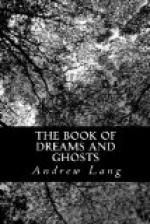The professor awoke, bounded out of bed, as Mrs. Hilprecht testifies, and was heard crying from his study, “It is so, it is so!” Mrs. Hilprecht followed her lord, “and satisfied myself in the midnight hour as to the outcome of his most interesting dream”.
The professor, however, says that he awoke, told his wife the dream, and verified it next day. Both statements are correct. There were two sets of drawings, one in the study (used that night) one used next day in the University Library.
The inscription ran thus, the missing fragment being restored, “by analogy from many similar inscriptions":—
TO THE GOD NIBIB, CHILD
OF THE GOD BEL,
HIS LORD
KURIGALZU,
PONTIFEX OF THE GOD BEL
HAS PRESENTED IT.
But, in the drawings, the fragments were of different colours, so that a student working on the drawings would not guess them to be parts of one cylinder. Professor Hilprecht, however, examined the two actual fragments in the Imperial Museum at Constantinople. They lay in two distinct cases, but, when put together, fitted. When cut asunder of old, in Babylon, the white vein of the stone showed on one fragment, the grey surface on the other.
Professor Romaine Newbold, who publishes this dream, explains that the professor had unconsciously reasoned out his facts, the difference of colour in the two pieces of agate disappearing in the dream. The professor had heard from Dr. Peters of the expedition, that a room had been discovered with fragments of a wooden box and chips of agate and lapis lazuli. The sleeping mind “combined its information,” reasoned rightly from it, and threw its own conclusions into a dramatic form, receiving the information from the lips of a priest of Nippur.
Probably we do a good deal of reasoning in sleep. Professor Hilprecht, in 1882-83, was working at a translation of an inscription wherein came Nabu—Kudurru—usur, rendered by Professor Delitzsch “Nebo protect my mortar-board”. Professor Hilprecht accepted this, but woke one morning with his mind full of the thought that the words should be rendered “Nebo protect my boundary,” which “sounds a deal likelier,” and is now accepted. I myself, when working at the MSS. of the exiled Stuarts, was puzzled by the scorched appearance of the paper on which Prince Charlie’s and the king’s letters were often written and by the peculiarities of the ink. I woke one morning with a sudden flash of common-sense. Sympathetic ink had been used, and the papers had been toasted or treated with acids. This I had probably reasoned out in sleep, and, had I dreamed, my mind might have dramatised the idea. Old Mr. Edgar, the king’s secretary, might have appeared and given me the explanation. Maury publishes tales in which a forgotten fact was revealed to him in a dream from the lips of a dream-character (Le Sommeil et les Reves, pp. 142-143. The curious may also consult, on all these things, The Philosophy of Mysticism, by Karl du Prel, translated by Mr. Massey. The Assyrian Priest is in Proceedings, S.P.R., vol. xii., p. 14).




